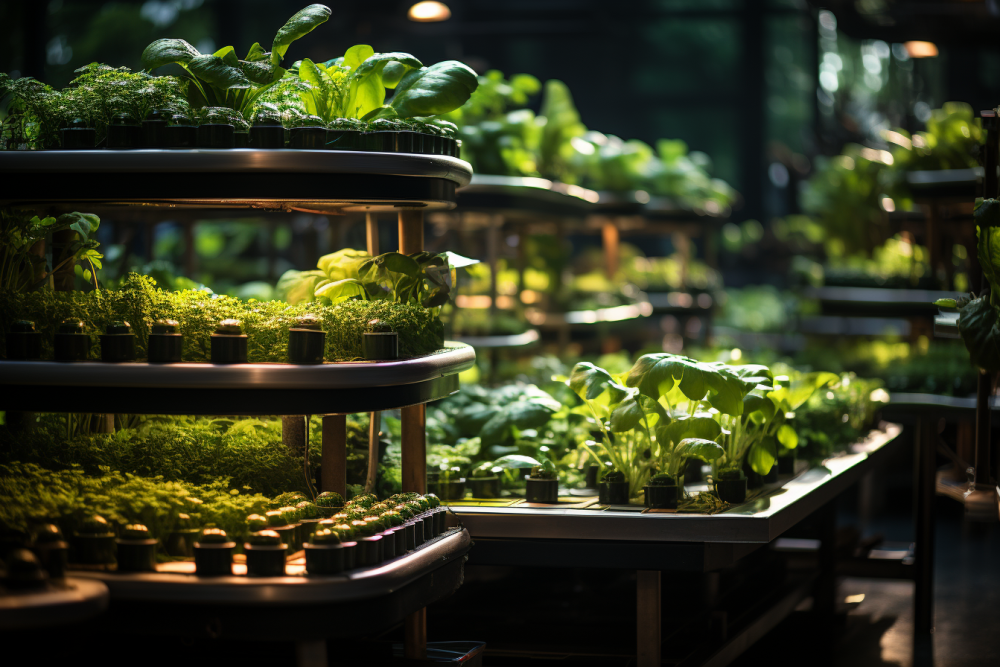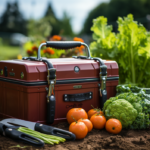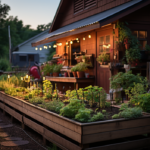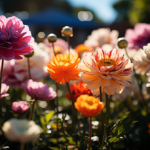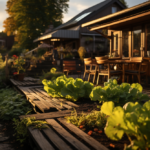Table of Contents
Essential Equipment and Methods for Successful Hydroponic Gardening
Hey there, budding gardeners! Have you ever dreamed of having a lush, green garden blooming right in your own home? Well, look no further because hydroponic gardening might just be the answer you’ve been searching for! Whether you have limited outdoor space, a black thumb, or simply want to try your hand at something new, hydroponics offers a refreshing and efficient way to grow plants without soil.
In this beginner’s guide, we’ll take you through the basics of hydroponic gardening, focusing on the crucial tools and techniques you’ll need to get started. No, you don’t need a degree in botany or a full-scale laboratory—hydroponic gardening can be straightforward and enjoyable, even for beginners.
So, what exactly is hydroponic gardening? Simply put, it’s a method of growing plants using nutrient-rich water instead of soil. By providing the plants with the necessary nutrients directly, hydroponics allows for faster growth, higher yield, and greater control over environmental conditions.
Throughout this guide, we’ll walk you through the essential equipment you’ll need to set up your own hydroponic garden. From basic systems like nutrient reservoirs and trays to more advanced tools like grow lights and pH meters, we’ll break it down for you, step by step.
So, grab your gardening gloves and let’s dive into the wonderful world of hydroponic gardening together! Get ready to cultivate your own personal oasis of thriving plants right in the comfort of your home. Let’s grow!
Choosing the Right Hydroponic System for Your Needs
When it comes to hydroponic gardening, one size doesn’t fit all. There are several types of hydroponic systems available, each with its own advantages and considerations. To help you decide on the right system for your needs, here are some key factors to consider:
- Nutrient Film Technique (NFT): In this system, a thin film of nutrient-rich water continuously flows over the roots. It’s best for small to medium-sized plants with short growth cycles, such as lettuce or herbs.
- Deep Water Culture (DWC): This popular system involves suspending the roots of the plants in a nutrient-rich solution. It’s ideal for beginners due to its simplicity and low cost, while also being suitable for larger plants like tomatoes and peppers.
- Drip System: This system feeds plants by periodically dripping nutrient solution onto their root systems. It offers great flexibility and is suitable for a wide variety of plants. However, it requires careful monitoring to prevent clogging and ensure proper water flow.
- Ebb and Flow System: Also known as flood and drain, this system periodically floods the plant’s root zone with nutrient solution and then drains it. It provides oxygenation to the roots and is suitable for larger plants with longer growth cycles.
- Aeroponics: In this high-tech system, plants are grown in an environment saturated with fine nutrient mist, allowing maximum oxygen exposure to the roots. It’s highly efficient but can be more complex and expensive, making it better suited for experienced gardeners.
Consider factors like your available space, the type of plants you want to grow, your budget, and your level of expertise when selecting a hydroponic system. Don’t be afraid to start small and gradually expand as you gain experience.
Remember, each system has its own unique requirements, such as lighting, ventilation, and pH monitoring. As you progress in your hydroponic gardening journey, you can experiment with different systems and techniques to find what works best for you.
By selecting the right hydroponic system for your needs, you’ll set yourself up for success and be well on your way to a thriving indoor garden. Stay tuned for the next part of our Beginner’s Guide, where we’ll dive into the essential tools and equipment you’ll need to bring your hydroponic garden to life!
Essential Tools for Setting Up Your Hydroponic Garden
Now that you’ve chosen the perfect hydroponic system for your needs, it’s time to gather the essential tools to get your garden up and running smoothly. Here are some crucial tools and equipment you’ll need:
- Grow Lights: Since hydroponic gardens are often grown indoors, proper lighting is crucial for the plants’ photosynthesis. LED or fluorescent grow lights are popular choices for providing the right spectrum of light for healthy plant growth.
- pH Meter: Monitoring and maintaining the pH levels of your nutrient solution is vital. A digital pH meter will help you keep track and make necessary adjustments to ensure your plants get the right nutrients at the right pH.
- Nutrient Solution: Unlike traditional soil gardening, hydroponic plants rely on nutrient-rich water for growth. You’ll need to invest in a quality hydroponic nutrient solution specific to the plants you’re growing. Follow the manufacturer’s instructions for proper usage.
- Air Pump and Stones: Oxygenation is crucial for healthy root development in hydroponics. An air pump and air stone will ensure there’s sufficient oxygen in the nutrient solution. This is particularly important for systems like Deep Water Culture (DWC) or Aeroponics.
- Net Pots and Grow Media: These components are essential for supporting the plants’ roots in the hydroponic system. Net pots provide a secure place for the plants to grow, while grow media (like clay pellets or rockwool) acts as a medium for root support and proper nutrient absorption.
- Water Reservoir and Pump: Depending on your hydroponic system, you’ll need a water reservoir to hold the nutrient solution. A submersible pump will help circulate the solution and deliver it to your plants.
Remember to follow the specific instructions provided with each tool and equipment to ensure their proper functioning. As you gain experience, you might explore additional tools like timers for automating the lighting and watering cycles.
With the right tools and equipment, you’ll be well on your way to a thriving hydroponic garden. In the next part of our Beginner’s Guide, we’ll dive into the crucial techniques and practices that will help you care for your hydroponic plants and maximize your garden’s growth potential. Stay tuned!
Understanding Nutrients and pH Levels in Hydroponic Gardening
When it comes to hydroponic gardening, understanding the role of nutrients and pH levels is essential for the health and success of your plants. Here’s what you need to know:
Nutrients:
- In hydroponic gardening, plants receive their essential nutrients directly from the nutrient solution.
- It’s crucial to provide the right balance of nutrients for optimal plant growth. These include macronutrients like nitrogen, phosphorus, and potassium, as well as micronutrients like iron, calcium, and magnesium.
- You can purchase pre-made hydroponic nutrient solutions or mix your own using specific hydroponic fertilizers. Follow the instructions carefully for dilution rates and application.
pH Levels:
- pH measures the acidity or alkalinity of the nutrient solution. Maintaining proper pH levels is essential for nutrient availability and absorption by the plants.
- Most plants prefer a pH range between 5.5 and 6.5. However, different plants may have specific pH preferences, so it’s essential to research the optimal pH range for the types of plants you’re growing.
- A pH that is too high or too low can lead to nutrient deficiencies or toxicities, negatively affecting plant growth and health.
- Regularly monitor the pH levels of your hydroponic system using a pH meter or test kit. Adjust the pH as needed by adding pH up (to raise pH) or pH down (to lower pH) solutions.
Maintaining Nutrient Balance and pH:
- Nutrient levels should be regularly monitored and adjusted to ensure your plants are receiving the right amount of nutrients.
- Flushing your system periodically with fresh water can help prevent nutrient buildup and maintain a proper nutrient balance.
- Regularly check and adjust the pH levels to keep them within the desired range. Aim for stability, as rapid pH fluctuations can stress your plants.
By understanding the importance of nutrients and pH levels in hydroponic gardening, you’ll be better equipped to provide the optimal growing conditions for your plants. In the next part of our Beginner’s Guide, we’ll delve into the crucial techniques and practices that will help you care for your hydroponic plants and maximize your garden’s growth potential. Stay tuned!
Lighting Solutions for Optimal Plant Growth
When it comes to hydroponic gardening, providing the right lighting is essential for your plants to thrive. Since most hydroponic gardens are grown indoors, you have complete control over the lighting conditions. Here are some lighting solutions to consider for optimal plant growth:
1. LED Grow Lights:
- LED lights are a popular choice for hydroponic gardens due to their energy efficiency and versatility.
- They produce the specific light spectrum required for photosynthesis, promoting healthy plant growth.
- LED grow lights come in various color options, allowing you to customize the lighting based on the growth stage of your plants.
- They produce less heat compared to traditional lighting solutions, reducing the risk of scorching your plants.
2. Fluorescent Grow Lights:
- Fluorescent lights are a budget-friendly option for beginners and are suitable for small to medium-sized hydroponic gardens.
- They come in two types: compact fluorescent lights (CFL) and tube fluorescent lights (T5).
- CFLs are compact and emit a good spectrum of light, making them suitable for smaller spaces.
- T5 fluorescent lights provide a wider coverage area and are ideal for larger hydroponic setups.
3. High-Intensity Discharge (HID) Lights:
- HID lights, such as metal halide (MH) and high-pressure sodium (HPS) lights, are powerful lighting options for larger hydroponic gardens.
- MH lights emit a blue spectrum of light, ideal for vegetative growth, while HPS lights emit a red spectrum, promoting blooming and fruiting.
- HID lights produce more heat and consume more energy compared to LED or fluorescent lights. Adequate ventilation and cooling are necessary when using HID lights.
4. Natural Lighting:
- If you have access to ample natural sunlight, you can supplement your hydroponic garden with natural light.
- Position your plants near windows or use light-reflective materials to maximize sunlight exposure.
- Keep in mind that natural light may vary by season and location, so ensure your plants get the required amount of light for optimal growth.
Remember to check the light requirements specific to the plants you are growing, as different plants have varying light needs. Additionally, provide the recommended hours of light exposure for each growth stage (vegetative and flowering).
By choosing the right lighting solution for your hydroponic garden, you’ll provide your plants with the energy they need for robust growth. In the next part of our Beginner’s Guide, we’ll explore the crucial techniques and practices for caring for your hydroponic plants. Stay tuned!
Effective Watering and Nutrient Delivery Methods
In hydroponic gardening, providing your plants with proper watering and nutrient delivery is crucial for their growth and overall health. Since hydroponics is a soil-less system, it’s essential to understand the best methods for watering and delivering nutrients. Here are some effective techniques:
1. Timing and Frequency:
- In hydroponics, plants require more frequent watering compared to traditional soil gardening since water and nutrients are delivered directly to the roots.
- Monitor your plants and the moisture level of the growing medium or the roots to determine the optimal watering frequency.
- Avoid overwatering, which can lead to root rot and other issues. Conversely, ensure the plants don’t experience prolonged dry periods.
2. Top-Feeding Systems:
- Top-feeding systems involve directly applying the nutrient solution to the surface of the growing medium or the root zone.
- Use a watering can, a hose, or a drip system to evenly distribute the nutrient solution.
- This method is commonly used for plants grown in containers or those with a solid growing medium like perlite or coconut coir.
3. Nutrient Film Technique (NFT):
- NFT involves continuously recirculating a thin film of nutrient-rich water over the roots.
- A sloping channel or gutter system is used to allow the nutrient solution to flow over the roots and then return to the reservoir for recirculation.
- This method relies on gravity for the nutrient delivery, ensuring the roots receive an adequate supply of water and nutrients.
4. Ebb and Flow (Flood and Drain) Systems:
- Ebb and Flow systems periodically flood the plant’s root zone with nutrient solution and then drain it.
- This cyclic process provides oxygenation to the roots and promotes healthy growth.
- Use a submersible pump to flood the root zone, and let the nutrient solution drain back into the reservoir.
5. Aeroponics:
- Aeroponics is a high-tech method where plants are grown in an environment saturated with a fine mist of nutrient solution.
- The mist is delivered through misting nozzles or sprayers, allowing the roots to absorb oxygen and nutrients.
- This method provides maximum oxygen exposure to the roots, promoting rapid and robust growth.
Remember to monitor the pH and nutrient levels of your nutrient solution, and adjust them as needed. Regularly flushing your system with fresh water can help prevent nutrient buildup and maintain a healthy balance.
By implementing effective watering and nutrient delivery methods, you’ll ensure that your hydroponic plants receive the necessary moisture and nutrients for optimal growth. In the next part of our Beginner’s Guide, we’ll explore additional techniques for maintaining a healthy hydroponic garden. Stay tuned!
Controlling Factors like Temperature and Humidity in Your Hydroponic Garden
Creating the optimal environment for your hydroponic garden is crucial for the success of your plants. Two key factors to monitor and control are temperature and humidity. Here’s what you need to know:
Temperature:
- Most plants thrive in temperatures between 65°F to 80°F (18°C to 27°C). However, specific plants may have different temperature requirements, so research the ideal range for your chosen plants.
- Maintain a stable temperature throughout the day and night to avoid fluctuations that can stress your plants.
- Use a thermometer to monitor the temperature of your grow space regularly.
- If the temperature is too high, consider implementing techniques to cool down the environment, such as using fans, ventilation systems, or air conditioning.
- Similarly, if the temperature is too low, use heating mats, heaters, or insulation to provide the necessary warmth.
Humidity:
- Humidity refers to the amount of moisture in the air. Maintaining proper humidity levels helps plants with transpiration and nutrient absorption.
- Ideal humidity levels for most plants range between 50% to 60%. However, during different growth stages, some plants may benefit from higher or lower humidity levels, so research specific requirements.
- Use a hygrometer to measure the humidity levels in your grow space.
- If the humidity is too high, use dehumidifiers or increase ventilation to prevent excess moisture, which can lead to mold and fungus issues.
- If the humidity is too low, consider using humidifiers or placing water trays near the plants to increase atmospheric moisture.
Light and CO2 Considerations:
- Keep in mind that different light sources and the photosynthesis process may influence the temperature and humidity of your grow space.
- HID lights, such as metal halide (MH) or high-pressure sodium (HPS) lights, can generate more heat, requiring additional cooling measures.
- CO2 supplementation may increase plant growth, but be cautious as it can also raise temperatures. Ensure adequate ventilation and monitor CO2 levels to avoid heat buildup.
Regularly monitor and adjust temperature and humidity levels based on your plants’ needs. Maintaining a stable and controlled environment will help promote healthy growth and prevent issues like mold or stressed plants.
In the next part of our Beginner’s Guide, we’ll explore the importance of proper plant pruning and maintenance techniques for a thriving hydroponic garden. Stay tuned!
Troubleshooting Common Issues in Hydroponic Gardening
Like any gardening method, hydroponics comes with its own set of challenges. Here are some common issues you might encounter in your hydroponic garden and tips to troubleshoot them:
1. Nutrient Imbalances:
- Nutrient imbalances can lead to nutrient deficiencies or toxicities, resulting in stunted growth, yellowing leaves, or other visible signs of stress.
- Regularly monitor the nutrient levels and pH of your nutrient solution. Adjust as needed to maintain a proper balance.
- Ensure you’re using a high-quality hydroponic nutrient solution and following the manufacturer’s recommendations for dilution rates and application.
2. Root Rot:
- Root rot is caused by excess moisture and poor oxygenation around the roots, leading to the growth of harmful fungi.
- Avoid overwatering and ensure proper drainage in your hydroponic system to prevent waterlogged roots.
- Incorporate air stones and provide adequate airflow to maintain oxygenation around the roots.
3. Pests and Diseases:
- Pests like aphids, spider mites, or whiteflies, as well as plant diseases, can affect your hydroponic plants.
- Regularly inspect your plants for any signs of pests or diseases. If detected, treat with appropriate organic or hydroponics-approved pesticides, fungicides, or insecticides.
- Maintain a clean and well-sanitized environment to reduce the risk of pests and diseases.
4. pH Fluctuations:
- pH fluctuations can hinder nutrient absorption and affect plant growth. Rapid pH swings can stress your plants.
- Monitor the pH of your nutrient solution regularly and make small adjustments to keep it within the desired range.
- Consider using pH buffers or stabilizers to help maintain stable pH levels.
5. Heat Stress:
- High temperatures can cause heat stress in your plants, leading to wilting, leaf curling, or even plant death.
- Ensure proper ventilation, fans, and cooling systems to keep the temperature within the optimal range.
- Consider implementing shading techniques or adjusting lighting schedules during peak heat periods.
6. Overcrowding:
- Overcrowding your hydroponic system can lead to poor airflow, increased humidity levels, and competition for light and nutrients.
- Provide adequate space between plants to allow for proper air circulation and growth.
- Regularly prune and trim your plants to control their size and prevent overcrowding.
By identifying and addressing these common issues in your hydroponic garden, you’ll be able to maintain a healthy and thriving growing environment. Stay vigilant, observe your plants closely, and be proactive in addressing any problems that arise.
In the next part of our Beginner’s Guide, we’ll explore harvesting techniques and tips for maximizing the yield of your hydroponic garden. Happy gardening!
Scaling Up: Expanding Your Hydroponic Garden
So you’ve mastered the basics of hydroponic gardening and now you’re ready to take it to the next level? Scaling up your hydroponic garden can be an exciting and rewarding endeavor. Here are some essential tips to help you expand your garden:
1. Assess Your Space:
- Start by evaluating the available space where you plan to expand your hydroponic garden. Consider factors like lighting, ventilation, and accessibility.
- Determine if you have enough room for additional systems or if you need to make adjustments to accommodate more plants.
2. Choose the Right System:
- Select a hydroponic system that suits your unique needs and fits the available space. Consider factors like the number of plants you want to grow, ease of maintenance, and scalability.
- Systems like NFT (Nutrient Film Technique) or vertical towers can be great options for maximizing space efficiency.
3. Maintain Consistency:
- Ensure consistency in your new set-up by using similar equipment, lighting, and nutrient solutions as your existing garden.
- This consistency will make it easier to manage and maintain your expanded hydroponic garden.
4. Adapt the Infrastructure:
- Adjust your infrastructure to accommodate the scaled-up garden. This may involve installing additional trays or channels, setting up more grow lights, or expanding your water reservoir capacity.
- Upgrade ventilation systems to ensure adequate airflow for larger gardens.
5. Consider Automation:
- As your hydroponic garden expands, it may become more challenging to manage all aspects manually. Consider investing in automation tools like timers, nutrient dosers, or pH controllers to streamline the process and improve efficiency.
6. Gradual Expansion:
- Start small and gradually expand your hydroponic garden. This will allow you to experiment, learn from any potential mistakes, and make adjustments along the way.
- As you gain experience, you can increase the number of plants and systems at a pace that suits your comfort level.
Scaling up your hydroponic garden requires careful planning and consideration. By assessing your space, choosing the right system, maintaining consistency, adapting your infrastructure, considering automation, and gradually expanding, you’ll be on your way to a thriving and bountiful garden.
In the final part of our Beginner’s Guide, we’ll share some tips on how to harvest your hydroponic plants and enjoy the fruits of your labor. Get ready to reap what you sow!
Exploring Different Types of Hydroponic Techniques
Hydroponic gardening offers a wide range of techniques to explore, allowing you to find the one that best suits your preferences and growing goals. Here are some popular hydroponic techniques to consider:
1. Nutrient Film Technique (NFT):
- In NFT, a thin film of nutrient-rich water flows over the plant roots, providing them with the necessary nutrients.
- This technique uses a sloping channel or tube system to allow the nutrient solution to circulate and then return to the reservoir.
- NFT is suitable for smaller plants with shorter growth cycles like herbs or lettuce.
2. Deep Water Culture (DWC):
- DWC involves suspending the plant roots in a nutrient solution, allowing them to absorb oxygen and nutrients directly.
- In this technique, an air pump and air stones provide oxygenation to the roots, promoting healthy growth.
- DWC is beginner-friendly, cost-effective, and suitable for various plants including leafy greens and larger vegetables.
3. Drip System:
- The drip system involves delivering nutrient solution to the plants through drip emitters or drippers.
- These emitters slowly drip the solution onto the growing medium or the base of the plants, ensuring consistent moisture and nutrient supply.
- Drip systems offer versatility, as they can be configured for different plant types and growth stages.
4. Ebb and Flow (Flood and Drain):
- Ebb and Flow systems periodically flood the plant’s root zone with nutrient solution and then drain it back into the reservoir.
- This cyclic process provides nutrients and oxygen to the roots, promoting robust growth.
- Ebb and Flow is suitable for larger plants with longer growth cycles and offers good aeration to the roots.
5. Aeroponics:
- Aeroponics is a high-tech technique where plant roots are suspended in a mist or fog of nutrient solution.
- By nourishing the roots with a fine mist, aeroponics provides abundant oxygenation and nutrient absorption.
- This technique results in rapid growth and is ideal for plants with shorter growth cycles.
Each hydroponic technique has its own benefits and considerations. Consider factors like space availability, budget, and the type of plants you want to grow when choosing the technique that suits you best.
Remember to experiment and have fun as you explore different hydroponic techniques. There’s room for creativity and customization within each method. Enjoy the journey of discovering the wonders of hydroponic gardening!
In the concluding part of our Beginner’s Guide, we’ll provide some helpful tips for maintaining a successful hydroponic garden and making the most of your growing experience. Stay tuned for the final installment!
Maximizing Yield: Harvesting and Maintaining Your Hydroponic Garden
Congratulations on making it to the final installment of our Beginner’s Guide to Hydroponic Gardening! Now it’s time to reap the rewards of your hard work by harvesting and maintaining your hydroponic garden. Here are some crucial tips to help you maximize your yield:
1. Harvesting Techniques:
2. Pruning and Maintenance:
3. Nutrient Solution Maintenance:
4. Cleaning and Sanitizing:
5. Record Keeping and Experimentation:
By implementing these tips for harvesting, maintaining, and maximizing the yield of your hydroponic garden, you’ll enjoy a continuous supply of fresh and healthy produce. Embrace the learning process, stay curious, and adapt as you gain experience.
Remember, hydroponic gardening is a dynamic and versatile method, offering endless possibilities for growing your own food. Enjoy the journey and the delicious rewards of your hydroponic garden!
We hope this Beginner’s Guide has equipped you with the essential tools and techniques to embark on your hydroponic gardening adventure. Happy growing!
Conclusion
So there you have it, fellow green thumbs! Our Beginner’s Guide to Hydroponic Gardening has covered the crucial tools and techniques you need to start your own indoor garden adventure. From choosing the right hydroponic system to understanding the importance of nutrients, pH levels, and lighting, we hope this guide has given you the confidence to dive into the world of soil-less gardening.
With the proper tools and equipment, such as grow lights, pH meters, and nutrient solutions, you can create a thriving hydroponic garden right in your own home. Remember to experiment, learn from any challenges that come your way, and adapt your techniques as needed. Hydroponic gardening allows you to have control over the growing environment and opens up endless possibilities for growing a variety of plants throughout the year.
Whether you’re a plant lover with limited outdoor space or simply curious to try a new gardening method, hydroponics offers a fun and rewarding way to grow your own food or create a vibrant indoor oasis. So grab your gardening gloves, get your hands dirty (or not!), and start cultivating your own hydroponic garden. Get ready to witness the wonders of soil-less gardening and enjoy the bountiful harvests that await you.
Happy gardening, and may your hydroponic journey be filled with growth, enjoyment, and plenty of fresh, homegrown goodness!

